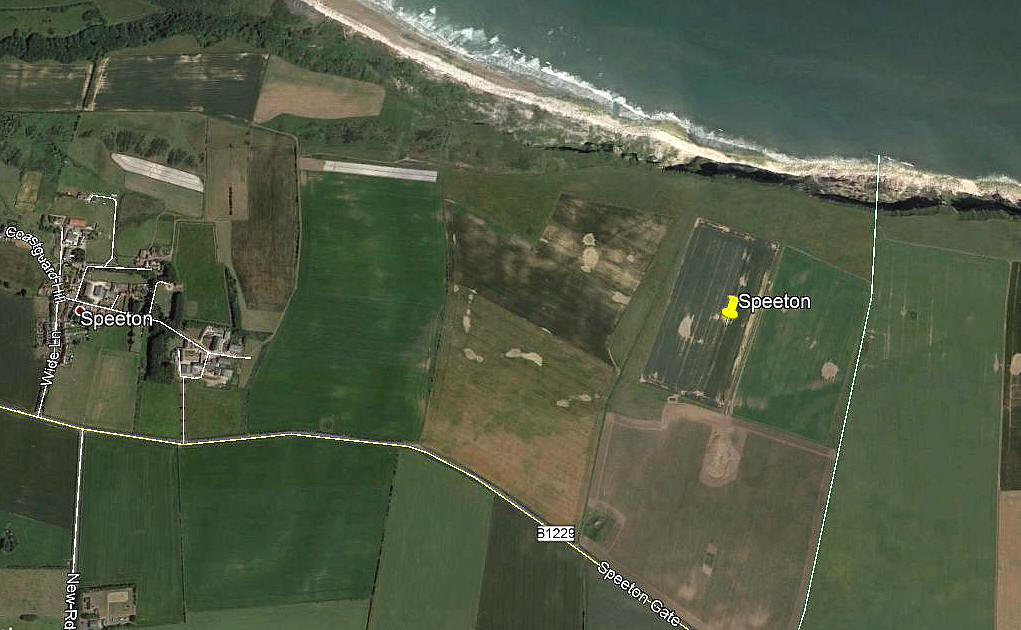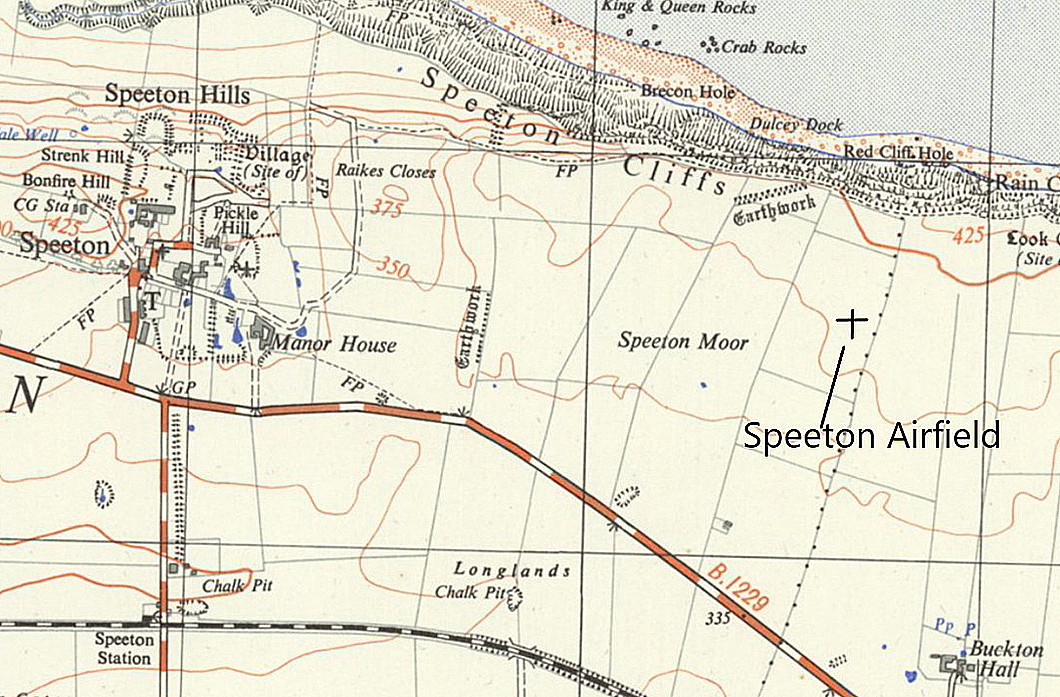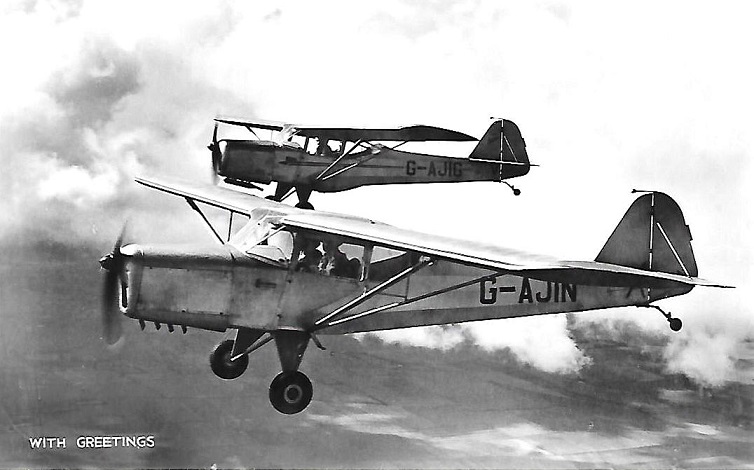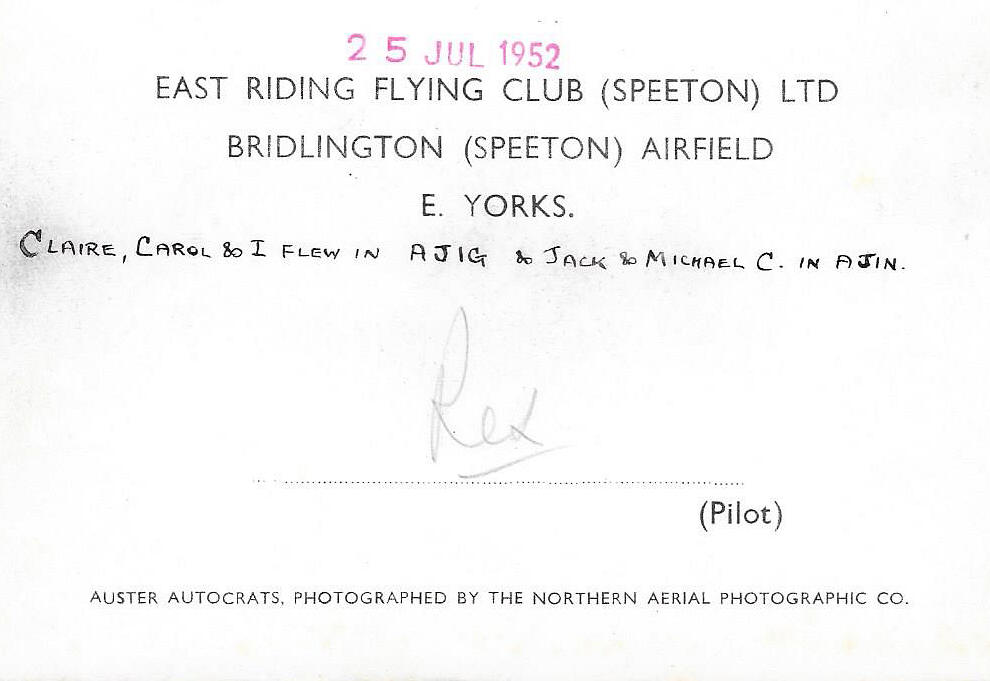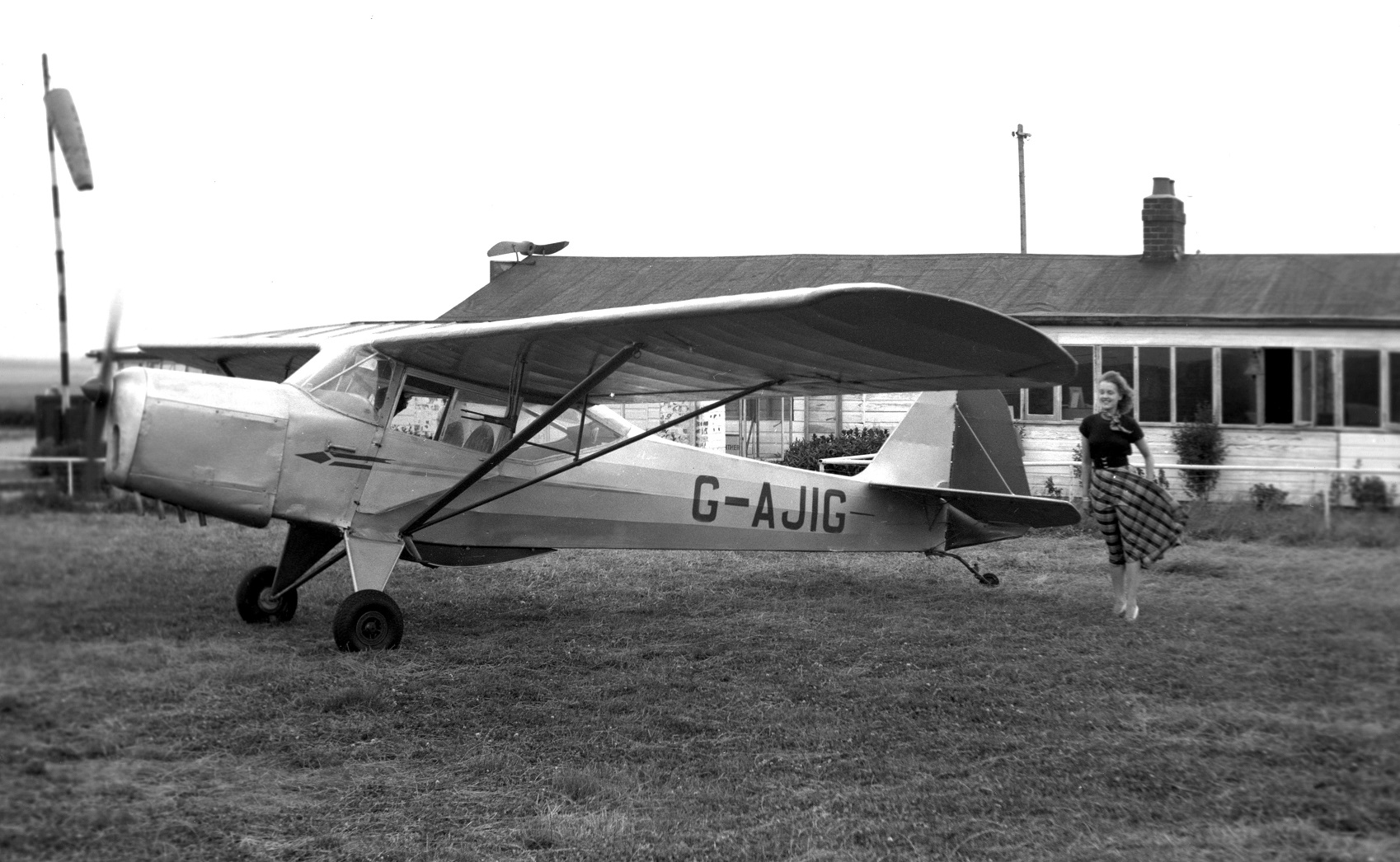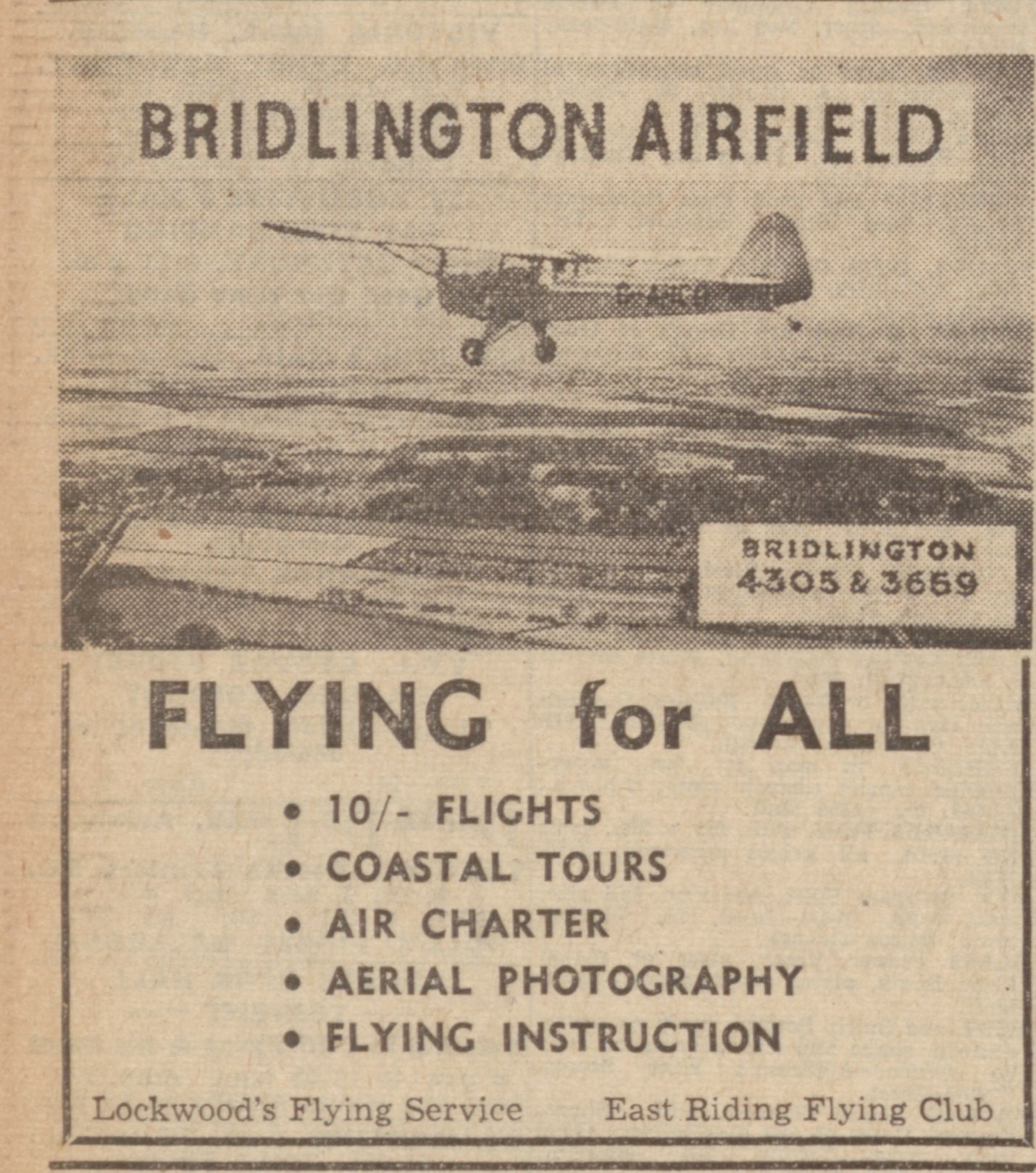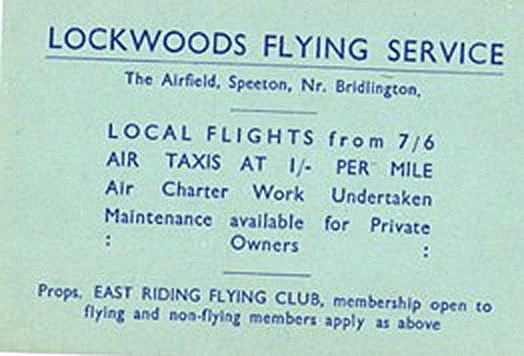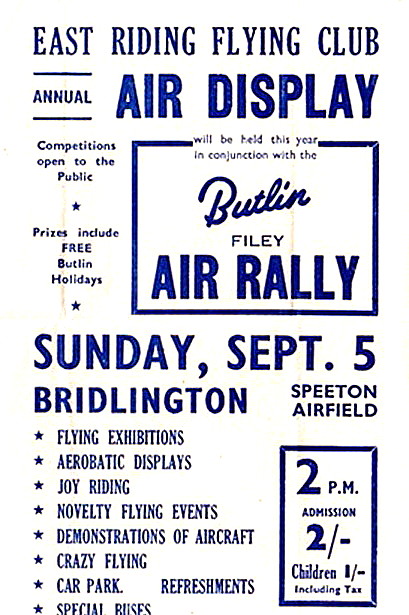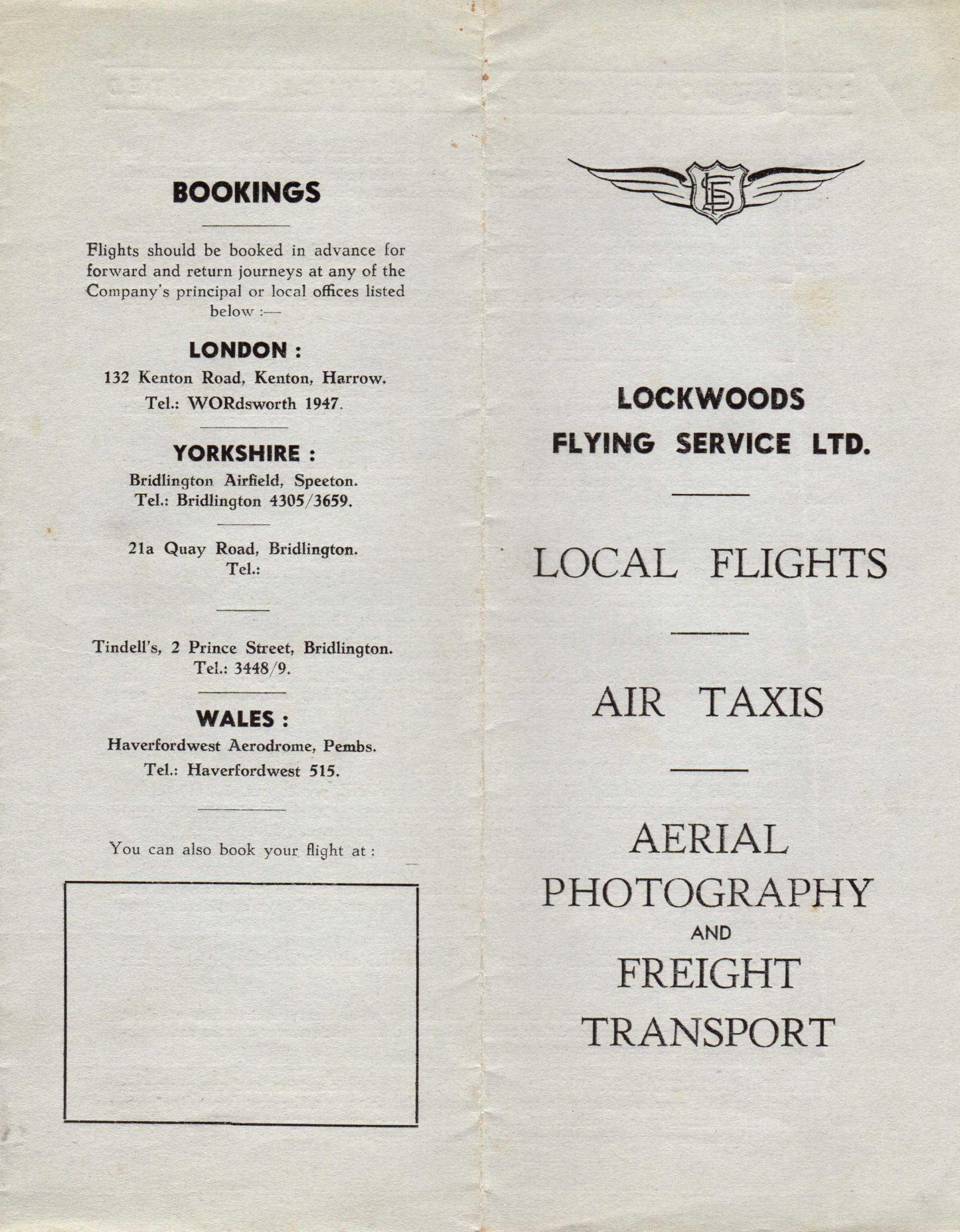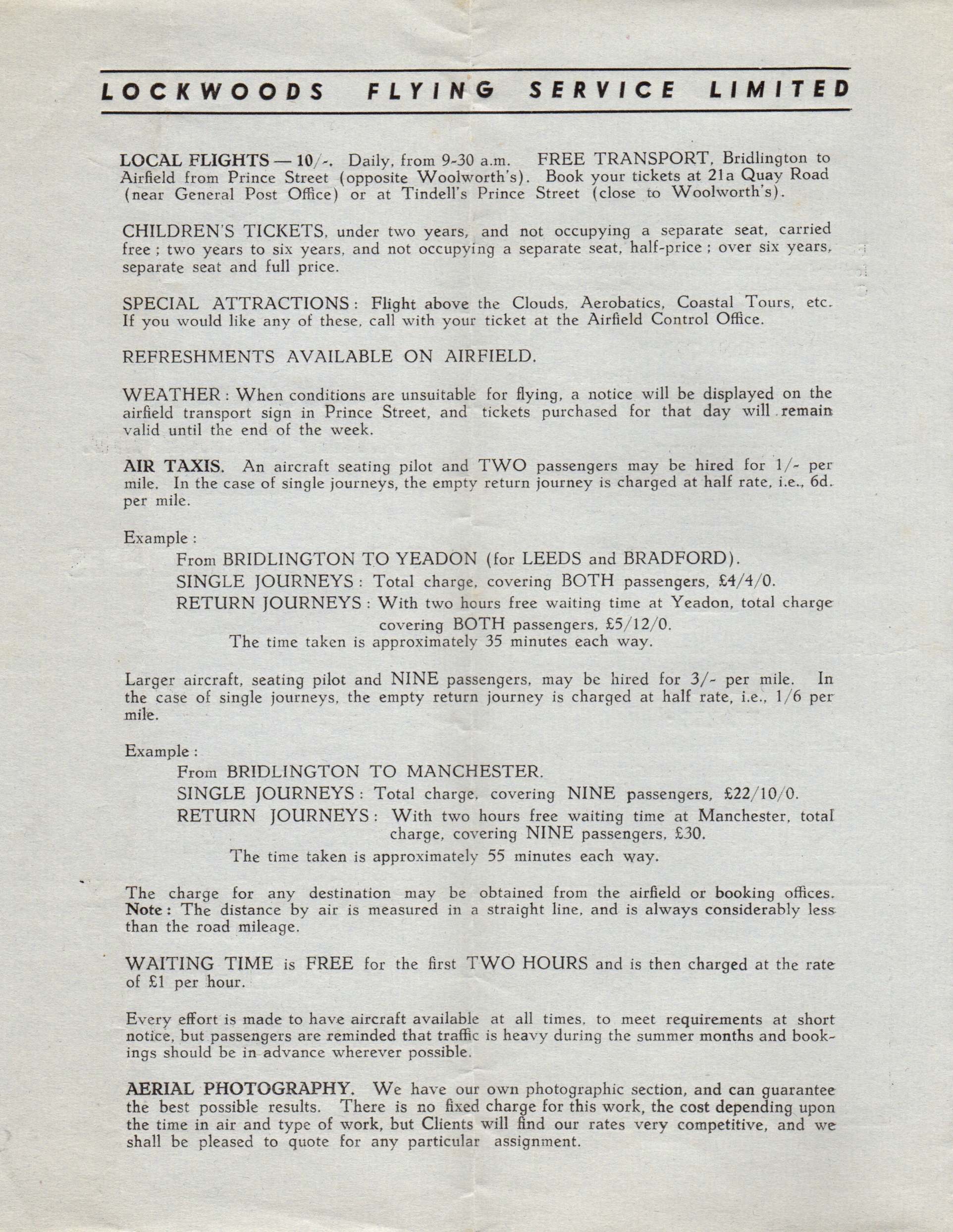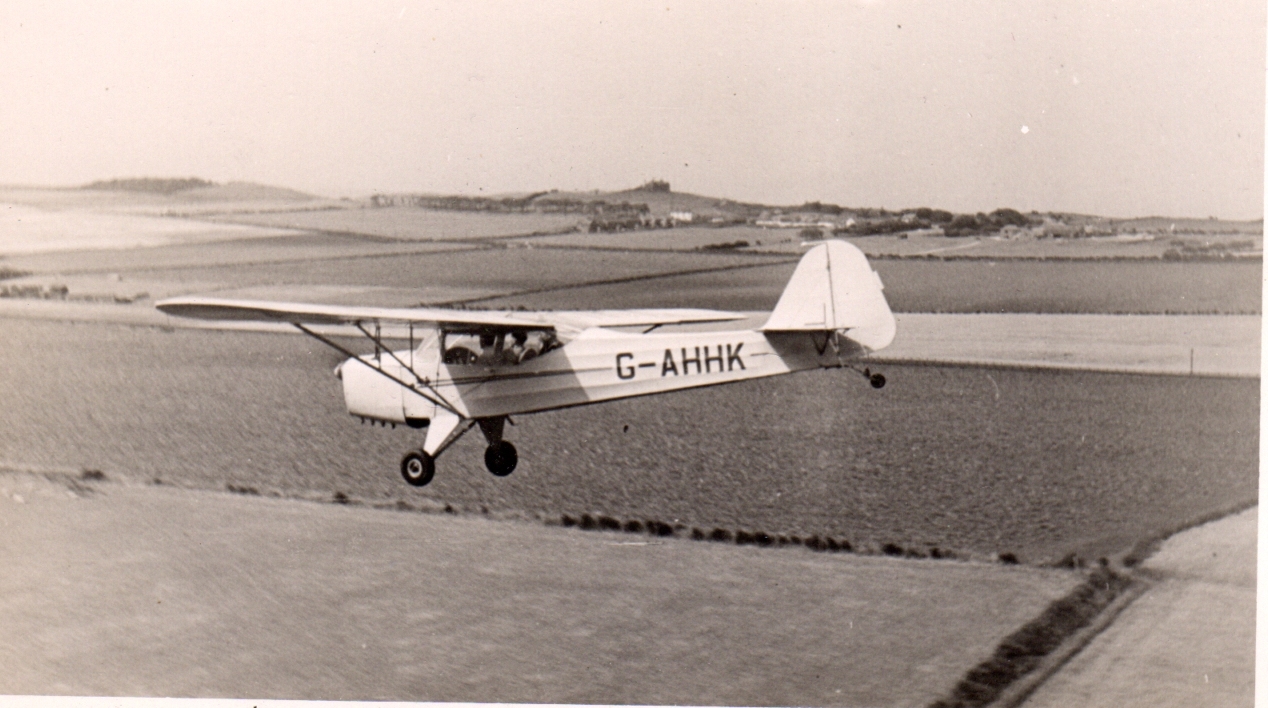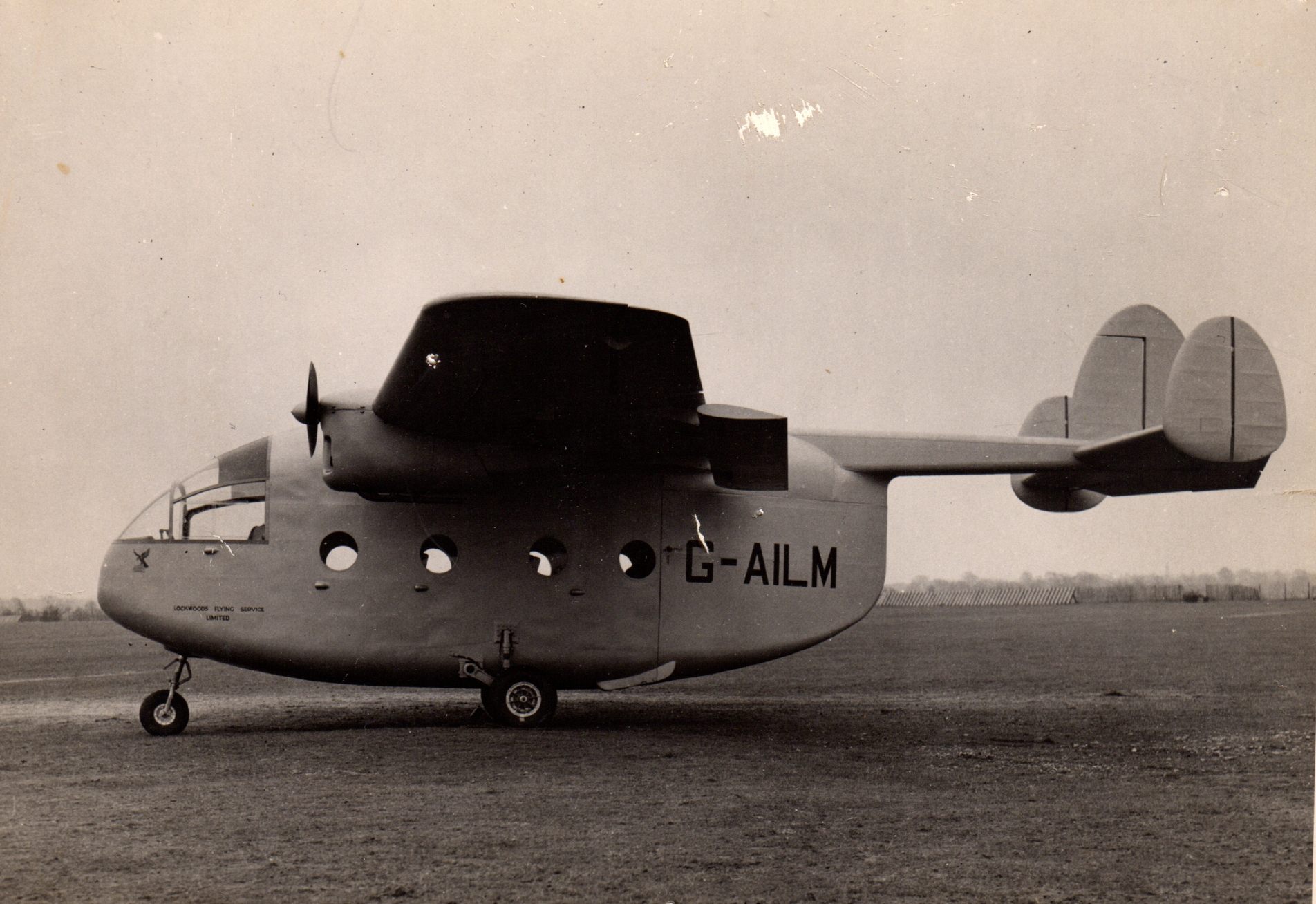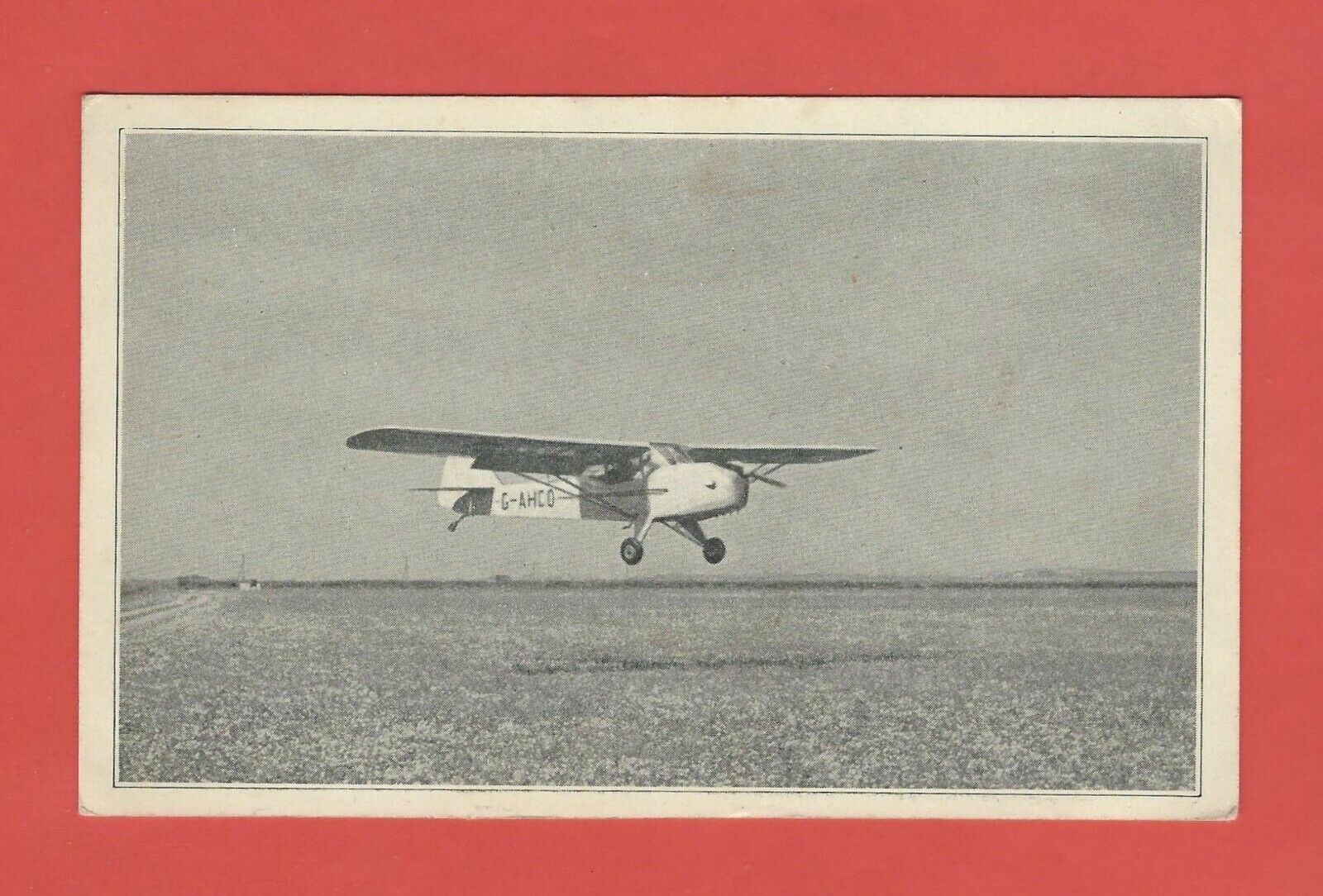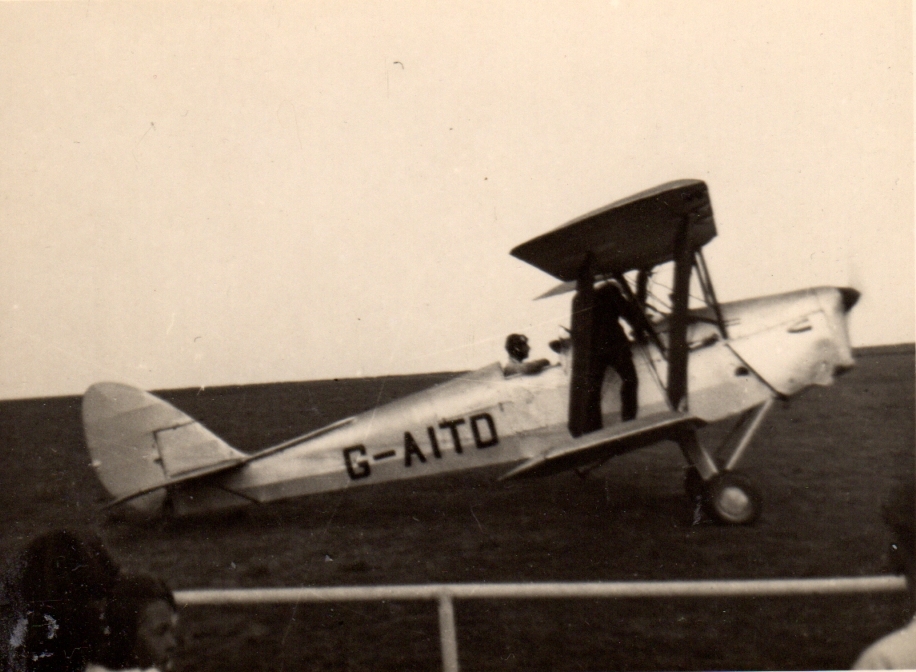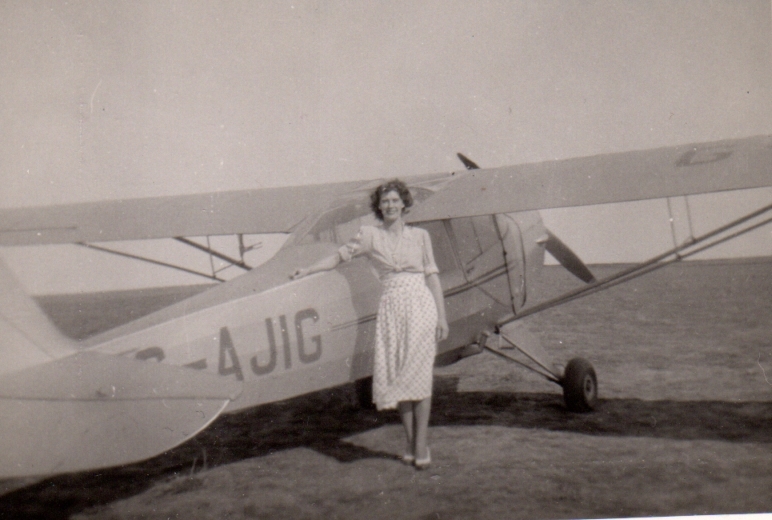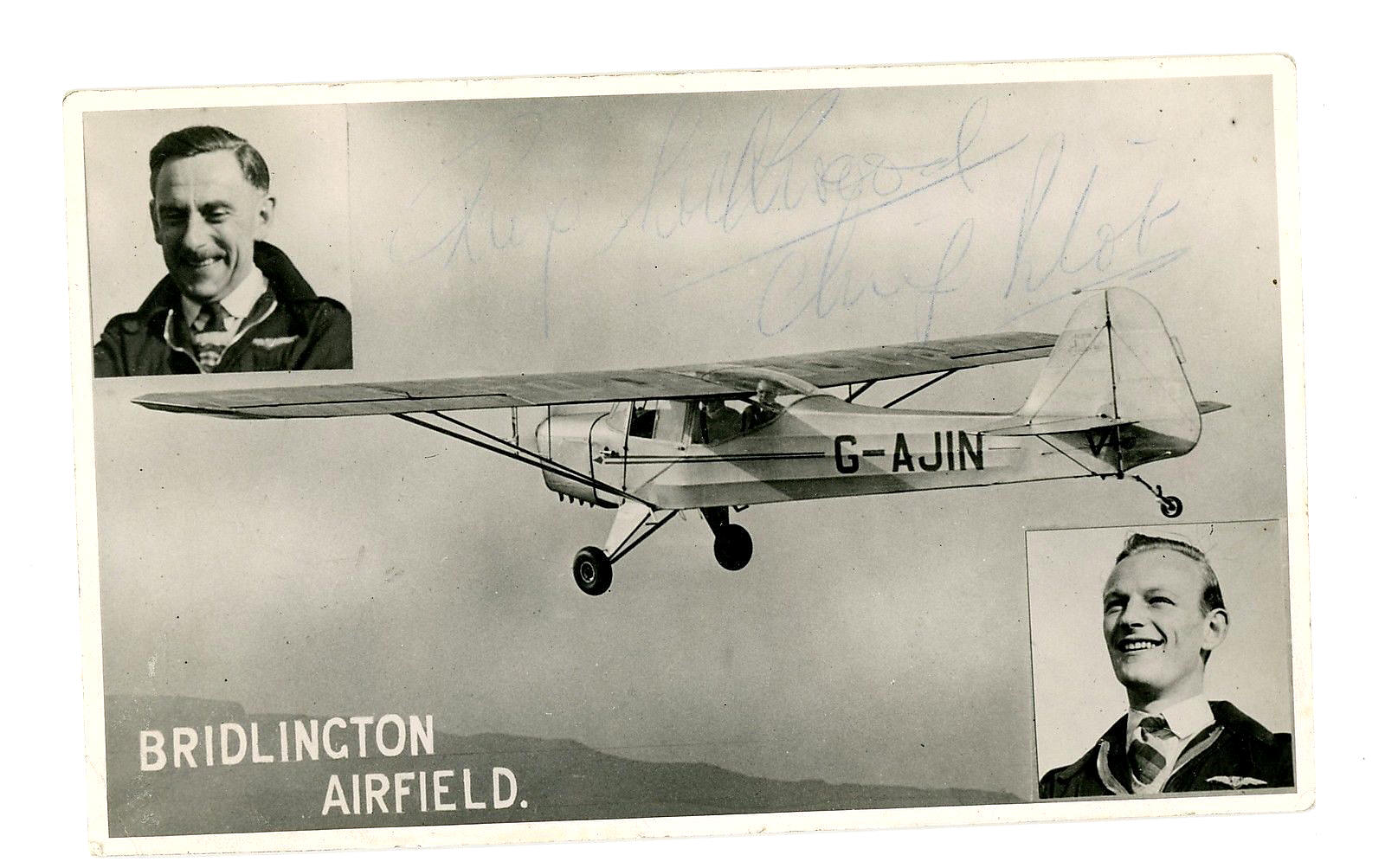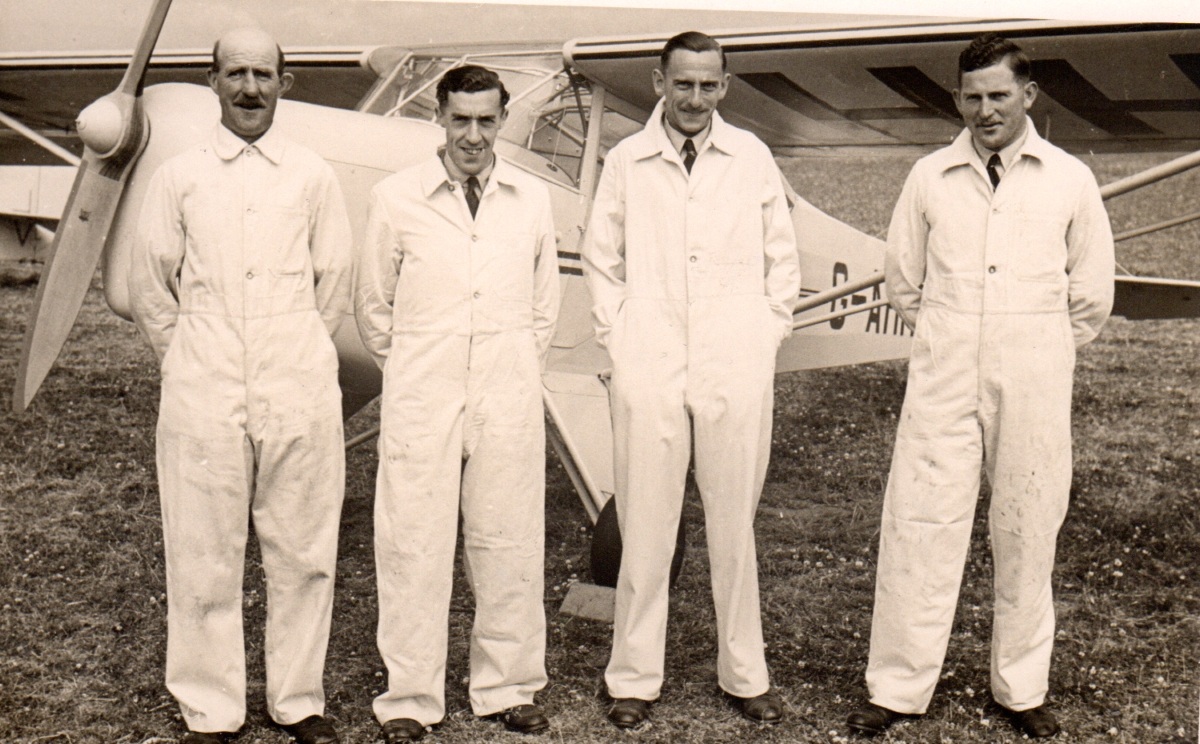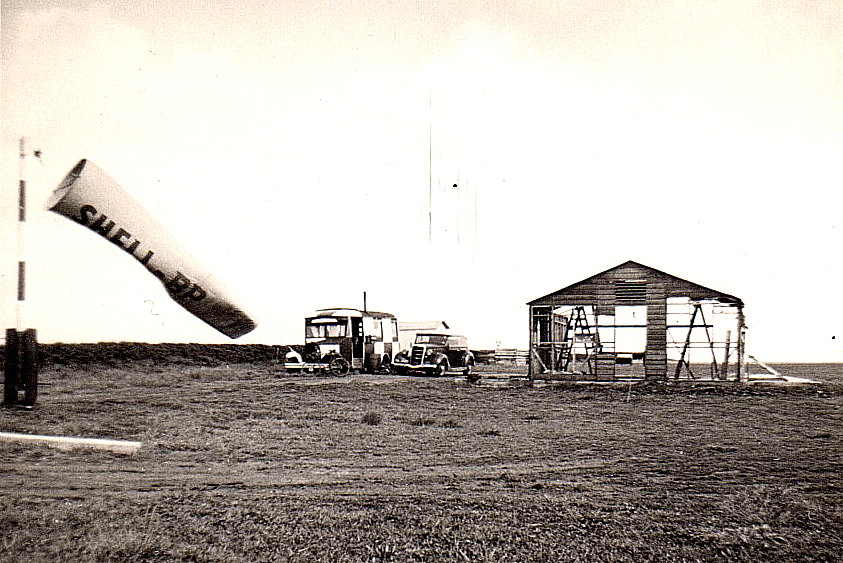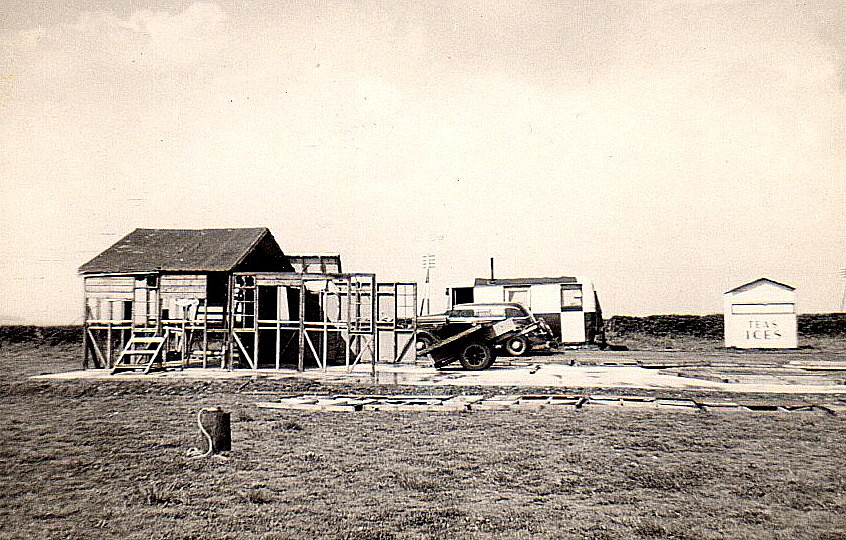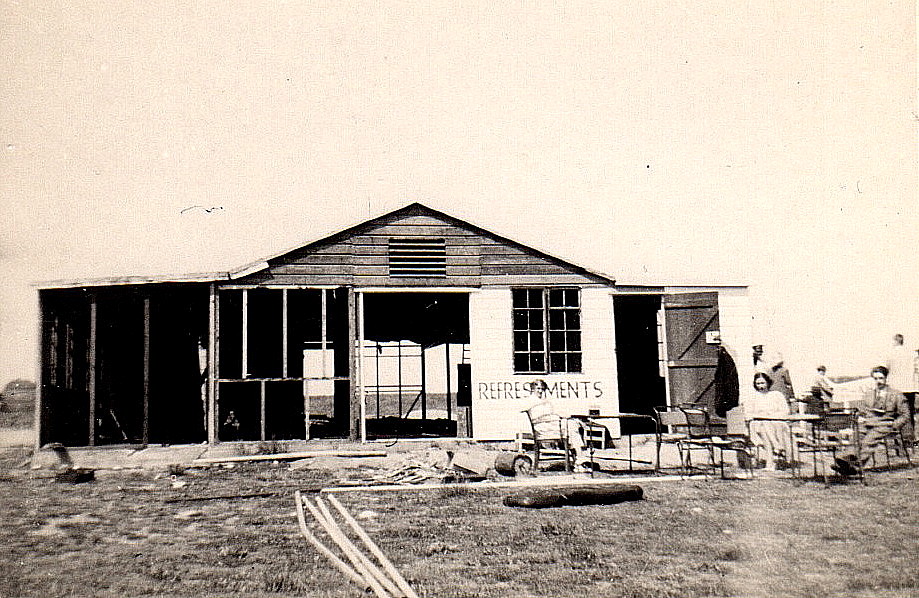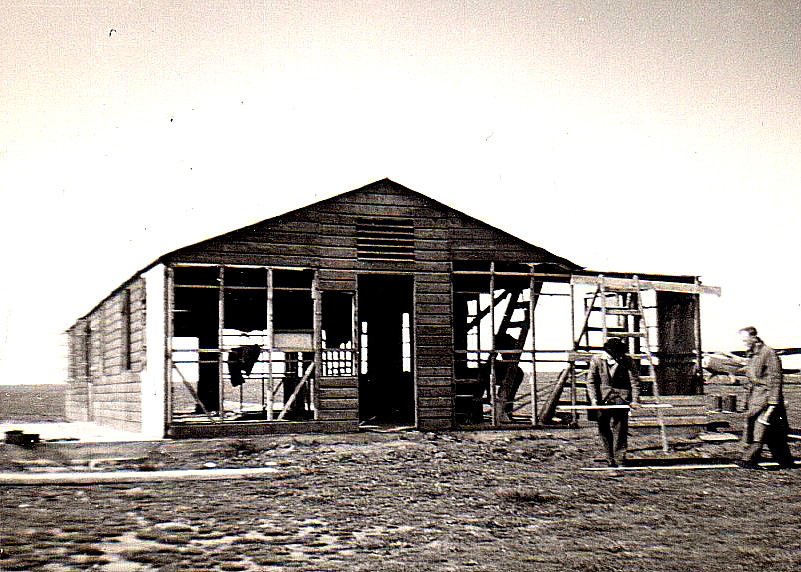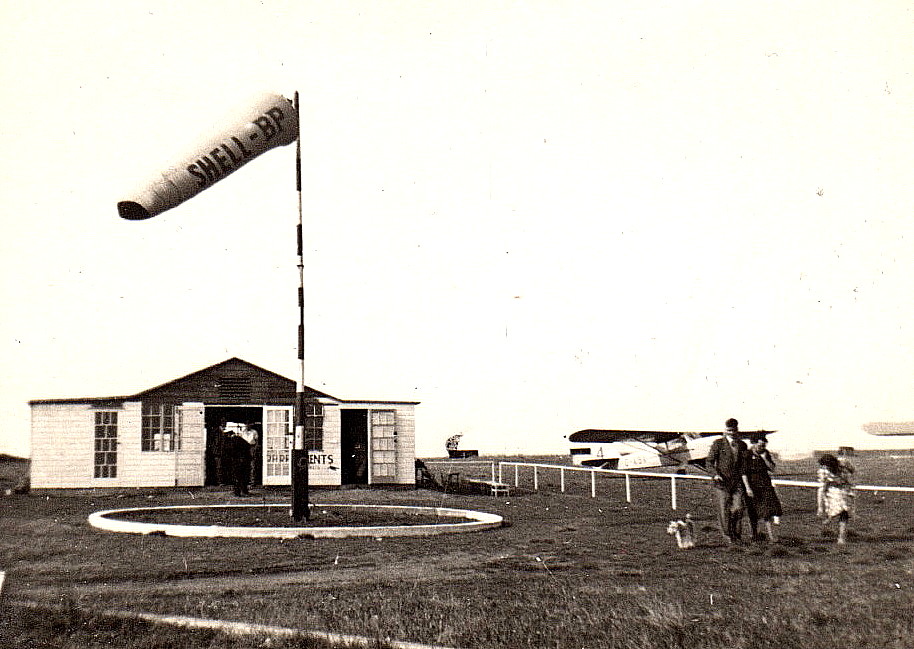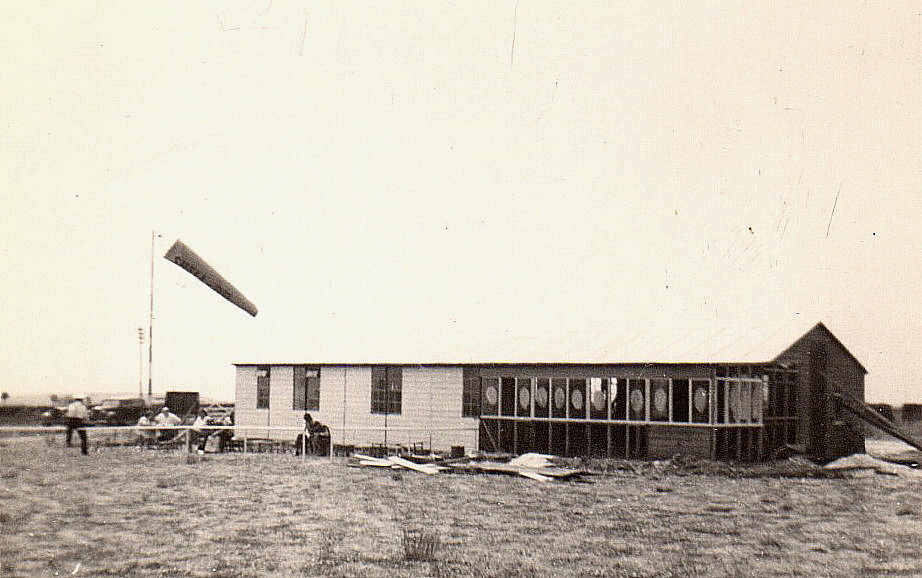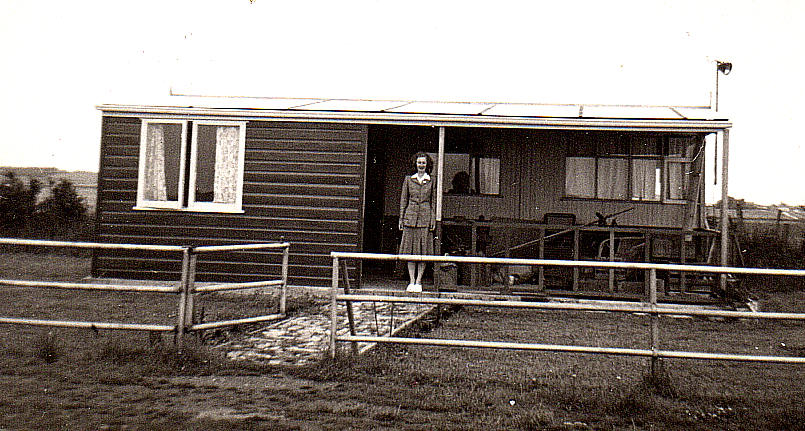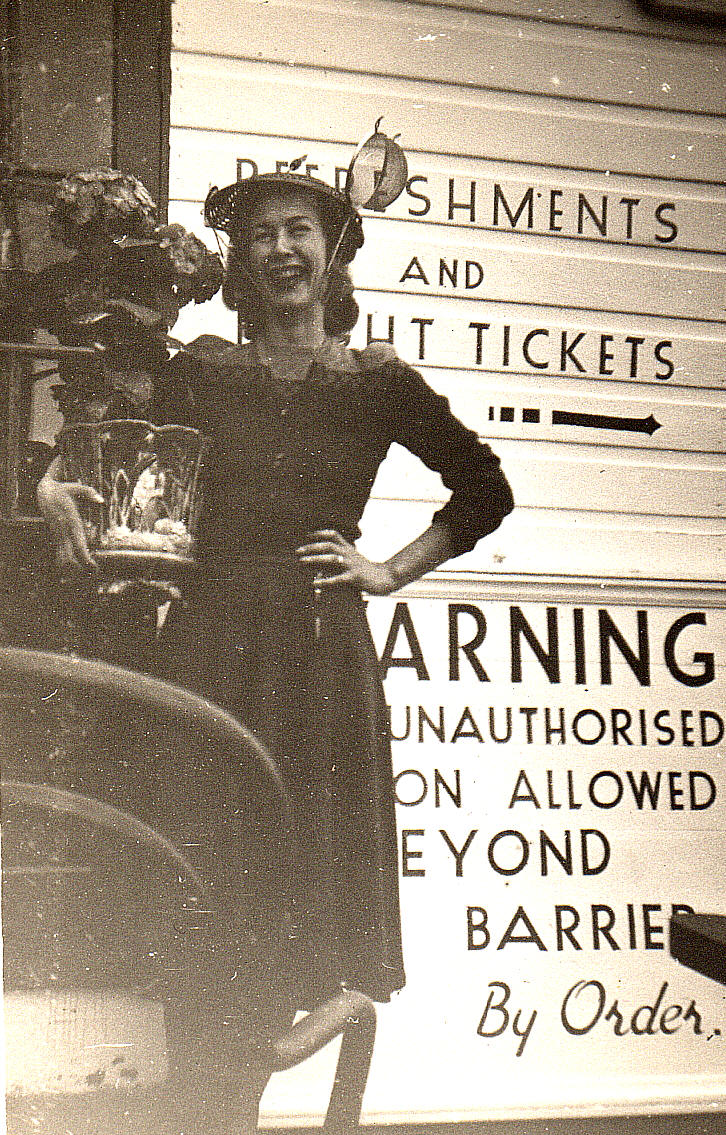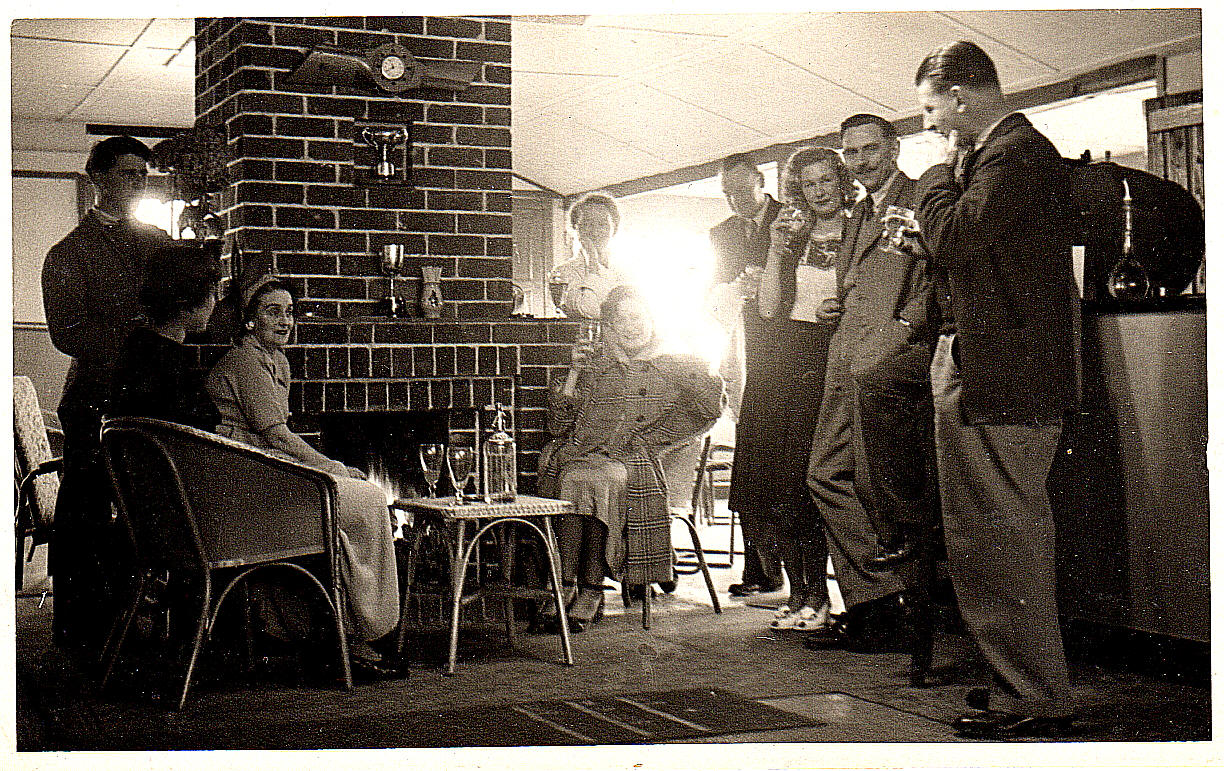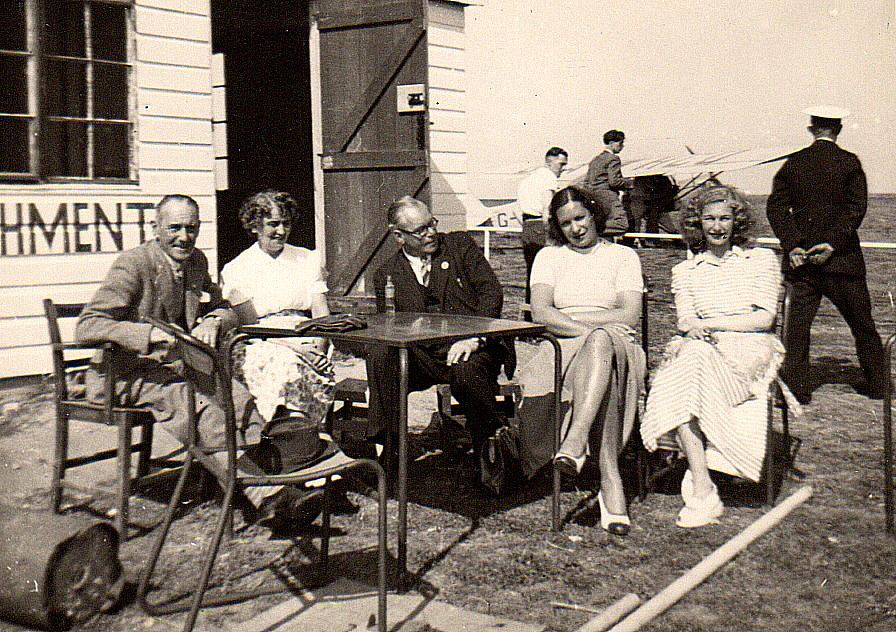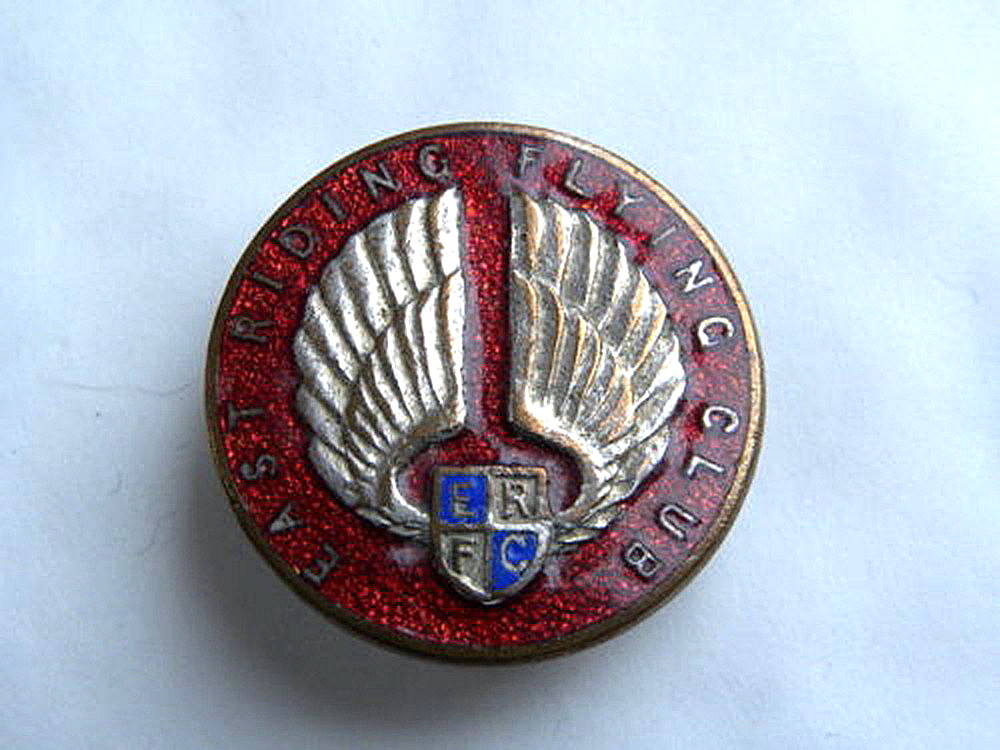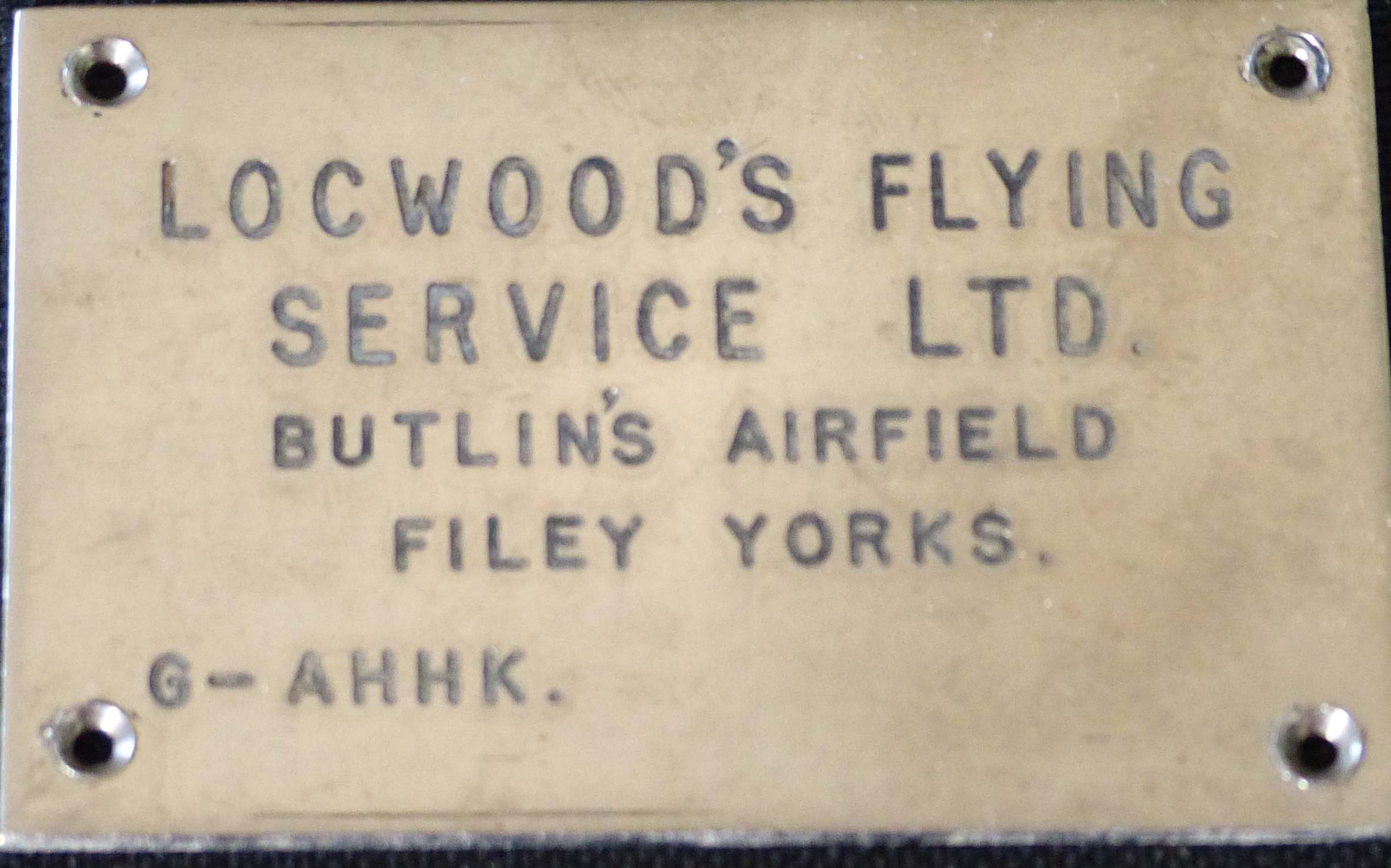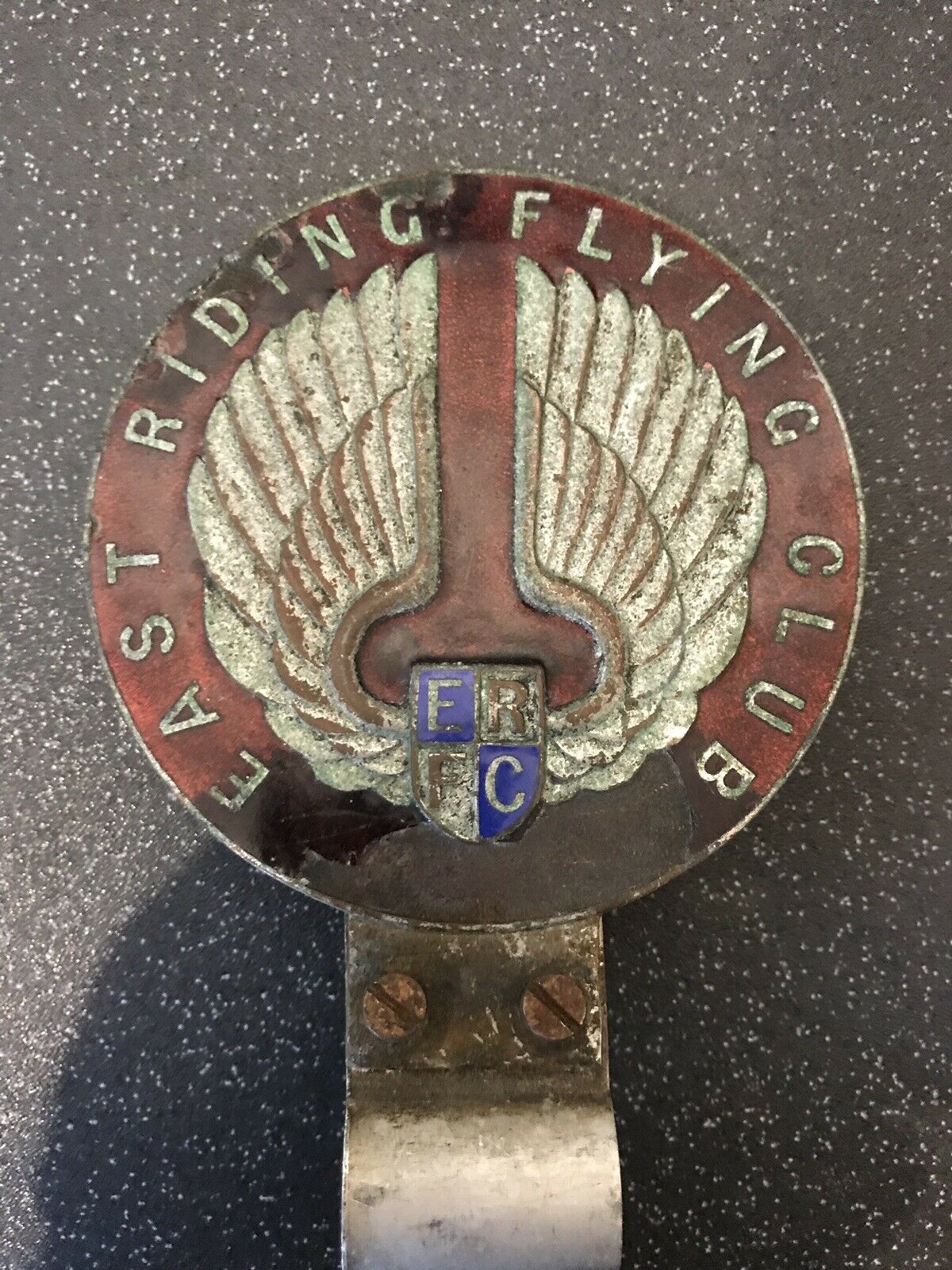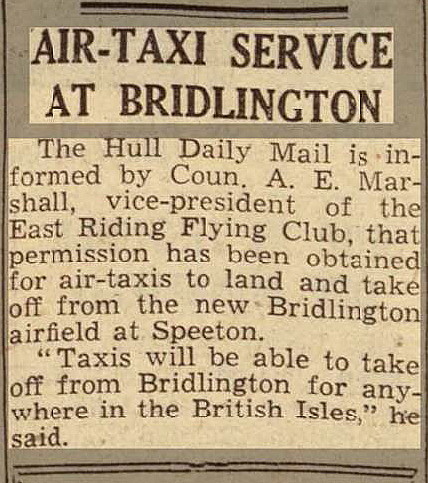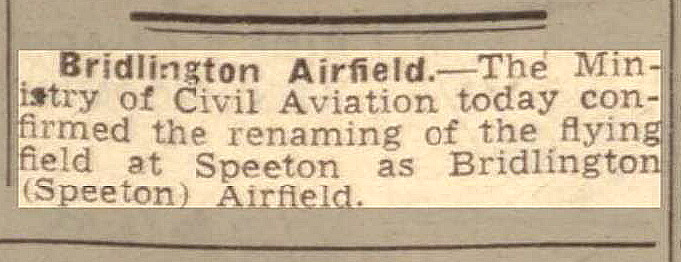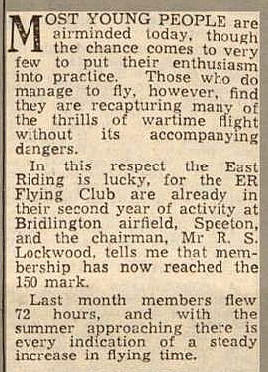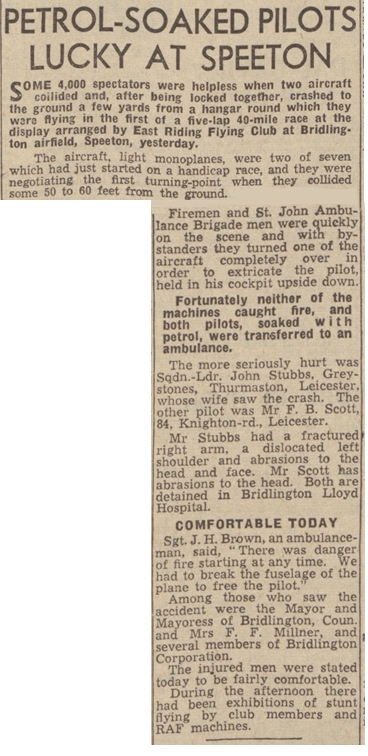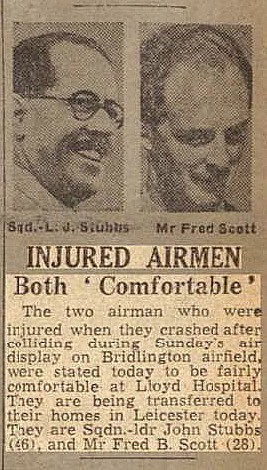Speeton Airfield
SPEETON AIRFIELD: Civil Airfield (Aka BRIDLINGTON AIRFIELD)
Note: Not to be confused with the later and nearby BRIDLINGTON airfield
Note: This picture was obtained from Google Earth ©. As so often in this 'Guide' I have the Airfields of Britain Conservation Trust to help in pin-pointing this location initially.
These three items were kindly provided by Mike Holder, a great friend of this 'Guide'. The notice was published in Flight magazine on the17th April 1953.
Note: These two pictures from a postcard, in this case the back and the front of postcard, were kindly sent by Mike Charlton who has an amazing collection. See: www.aviationpostcard.co.uk
Note: This rare picture was kindly sent by Roy Benstead. The attractive young lady is Audrey Anderson - who was having her first flight. The magic must have worked as they were married in 1955. What I find very interesting is that the engine was running, but nobody is at the controls and the wheels aren't chocked!
G-AJIG: As nearly always the case with most aircraft of this era, they often seemed to change hands very often. It was first registered to Auster at REARSBY (LEICESTERSHIRE) from the 28th March 1947 until the 15th April 1947. Was it really worth the trouble? It was then registered to Air Activites (Bridlington Airfield) from the 9th May 1947 until the 2nd July 1947. Trying to make sense of the flying sites around Bridlington really is a nightmare, and I feel fairly certain that the "Bridlington Airfield" address given for Air Activities was not SPEETON.
It was then registered to Lockwoods Flying Service (also Bridlington Airfield) from the 29th July 1947 until the 1st March 1950. Presumably mostly employed on pleasure flights, air-taxi, aerial photography etc. On the 6th April 1950 it was registered to the East Riding Flying Club at SPEETON until the 29th June 1955. Then after two more short ownerships, one at PORTSMOUTH airport, it was exported to West Germany as D-EGAD in July 1956.
G-AJIN. Following a roughly parallel path to G-AJIG, first registered to Auster on the 24 April 1947 until the 28th May 1947, G-AJIN also went to Air Activites, from the 4th June 1947 until the 2nd July 1947. Barely a month! It was then registered to Lockwoods Flying Services from the 29th July 1947 until the 1st March 1950. Ever since WW1, and quite probably even today for many GA businesses, the main problem is how to structure their activities to survive the inevitable winter downturn.
Here again, G-AJIN was also registered to the East Riding Flying Club, from the 6th April 1950 until the 20th June 1955. And, just like G-AJIG, it also had two short changes of owner, one at PORTSMOUTH airport before being exported to West Germany as D-EJYN.
Another Auster once briefly operated by the East Riding Flying Club was the Auster J/1 Autocrat, G-AJRE, registered to them from 08.06.54 until 05.01.55.
Operated by: Mr Raymond Lockwood (Lockwoods Flying Services
Flying Club: East Riding Flying Club (Founded in 1946 by Mr Raymond Lockwood)
Location: Half a mile E from Speeton railway station, roughly 4nm NNW of Bridlington town centre
Period of operation: July 1946 to June 1955
NOTES: I found these details in the 1957 The Aeroplane directory, lent to me by a good friend Peter Hart in 2018 from his fathers collection. And, as far as I can see, it deserves a seperate listing.
Incredibly, just a few months later in 2018, Mike Charlton sent me these pictures. Of a site I had no idea about previously. I wonder how many more there are?
There is I think an interesting detail on the back of the postcard. To quote, "Claire, Carol and I flew in AJIG." But the Auster Autocrat was a three seater! Presumably two were young children and jammed into the rear seat.
MORE INFO
In November 2022, Mr Graham Frost, a great friend of this 'Guide', tells us that East Riding Flying Club also operated at least two more aircraft. These being the Miles M65 Gemini 1A G-AMBH, registered here from 13.05.53 until 27.04.57. And, the de Havilland DH82A Tiger Moth G-ANRE which only stayed a few months, from 03.05.54 until 18.01.55. Perhaps the joys of open cockpit flying wore off in the Yorkshire winter?
Later Graham also tells us that East Riding Flying Club operated two Percival P.34 Proctor 3's. These being G-ALCO (ex LZ682) from 1953 to 1954, and G-ALFX (ex LZ695) from 1953 to 1957. Both of these being built by F Hills & Sons, Trafford Park, Manchester.
AND MORE VALUABLE INFORMATION
In March 2025 I was kindly contacted by Mr Peter Lockwood, the son of Capt. R S Lockwood, who, together with Mr C J Britton, formed Lockwoods Flying Services in the spring of 1946. He has been engaged in putting together a history of his fathers business interests at SPEETON, which includes the subsidiary company East Riding Flying Club. It is a complex story in many ways, so this account is by no means intended to tell the whole history.
To date, (2025), the aircraft operated, (some purchased, others hired or on loan), appears to be:
Auster J/1 Autocrat = G-AGYD, G-AHCO, G-AHHK, G-AIBX, G-AJIG, G-AJIN and G-AJRE
Note: In this list of registration dates, Lockwoods Flying Services are LFS, East Riding Flying Club are ERFC.
G-AGYD (LFS) 27,05.46 to 01.03.50
G-AHCO (LFS) 17.06.46 to 11.01.50 (ERFC) 03.07.52 to 01.05.54
G-AHHK (LFS) 22.07.46 to 16.12.47
G-AIBX (LFS) 12.11.46 to 01.03.50 (ERFC) 06.04.50 to 21.05.50
G-AJIG (LFS) 29.07.47 to 01.03.50 (ERFC) 06.04.50 to 29.06.55
G-AJIN (LFS) 29.07.47 to 01.03.50 (ERFC) 06.04.50 to 20.06.55
G-AJRE (ERFC) 08.05.54 to 05.01.55
de Havilland DH82A Tiger Moth = G-AITD, G-AITE and G-ANRE
G-AITD (ex DE676) (LFS) 31.10.46 to 01.03.50 (ERFC) 22.11.50 to 01.05.54
G-AITE (ex DE132) (LFS) 31.10.46 to 05.10.48 (ERFC) 18.04.52 to 02.09.52
G-ANRE (ex N6851) (ERFC) 03.05.54 to 18.01.55
de Havilland DH89A Dragon Rapide = G-ALZF
G-ALZF (ex X7381) (ERFC) 02.08.50 to 04.07.51
Miles M.14A Hawk Trainer 3 = G-AITO (ex R1841) (ERFC) 06.04.50 to 21.05.50
Miles M.57 Aerovan = G-AILM (LFS) 22.11.46 to 05.06.48
Miles M.65 Gemini = (Type 1A) G-AKEJ (ERFC) 23.04.53 to 09.10.54
(Type 3C) G-AKGE (ERFC) 16.09.53 to 27.09.55
(Type 1A) G-AMBH (ERFC) 13.05.53 to 27.04.57
Percival P.34 Proctor 3 = G-AIES, G-ALCO and G-ALFX
G-ALCO (ex LZ682) (ERFC) 27.05.53 to 12.11.54
G-ALFX (ex LZ695) (ERFC) 14.04.53 to 20.04.57
Taylorcraft Plus D = G-AHSD (LFS) 01.10.46 to 01.03.50
STARTING OFF
Although an agreement had been made with the Butlins holiday camp at Filey to provide joyrides using an Auster purchased from Marshalls of Cambridge for £1150, they also decided to open up an airline service from HAVERFORDWEST, in south-west Wales, using a Miles M.57 Aerovan to Cork in Ireland. This failed because, although they offered to pay all expenses to HM Customs at Fishguard, (12 miles away), to clear one flight each way per week, they refused to partake. So, the Aerovan was transferred to FILEY with the staff from Wales.
With two extra Austers, in that first year operating from FILEY, they flew upwards of 10,000 passengers on joyrides and charter flights and it was soon obvious that the Filey site could not cope. And, worthy of note, his father is certain that he was only the second person to open up an aviation business in England after WW2.
GETTING ESTABLISHED AT SPEETON
This really was a new venture starting from scratch. A new clubhouse had to be built, together with a house for he and his wife to live in. Lockwoods Flying Services were establishing regular services to Leeds and York when disaster struck at the end of an air display in 1948 when two departing aircraft collided. Threats to sue the company arose, and legal advice was to let the company go into voluntary liquidation, as totally ignorant judges would have no idea about Air Law, and most probably side with the aggrieved families.
But, the East Riding Flying Club could continue, having grown to some 350 members in four years. This was not a happy situation and Mr Lockwood, decided to leave, becoming a flying instructor at ROBOROUGH, (Pymouth), before going to BEA in 1951. However, it appears that in April 1950, the East Riding Flying Club had taken over all operations at SPEETON. For the 1952 season only three Austers remained, the CFI being Rex Larsen, who later moved to SKEGNESS. This appears to have remained the situation until 1955 when flying ceased and the Austers sold. It also seems that the flying club changed its name to Desmond Heaton Ltd on the 10th June 1955 and SPEETON became derelict.
AN ARTICLE IN FLIGHT MAGAZINE
This article was published in the 1947, August 21st edition, from which I will choose a few excerpts.
"To mark the official opening of the East Riding Flying Club at Bridlington (Speeton) airfield on Thursday, August 14th, a friendly little aerial gymkhana was arranged to follow the Mayor's formal opening speech." This struck me as being interesting. "He and his party then had their baptème de l'air in a Miles Aerovan flown by Mr Lockwood of Lockwood's Flying Services Ltd." This is the only account I have heard of an Aerovan being employed for a civic function of this nature.
A Blackburn Firebrand was flown in from BROUGH to display, plus a Blackburn Club Tiger display also from BROUGH. A very novel display also took place with a Miles Messenger flown in from Air Schools Ltd from Derby. This would have been BURNASTON. I would have loved to see this demonstration flown by Sqdn Leader R L Porteous, later to be employed by Auster. Landing on one wheel, coming almost to a stop, then taking off again also only on one wheel!
Other attractions that day included a handicap air race, demonstrations by an Auster and the Aerovan, dive-bombing and a spot-landing competition.It may well have been a rather small affair as air shows go, but by heck, they certainly had real quality displays of the finest kind.
The Advert One was published in the Hull Daily Mail on the 9th May 1947. Advert Two is of the Air Display scheduled for the 5th September 1948.
The Brochure One picture shows the front and rear pages. Brochure Two shows the layout when opened up. It certainly illustrates just how flexible the operation was, offering a range of services.
The back of this postcard was signed by Ray Lockwood, Chief Pilot.
Taken shortly after the venture stated, from left to right: Mr Stavely, night watchman. Mr Don Ross, Engineer. Mr Raymond Lockwood, Chief Pilot and Mr Tony Richmond, a South African pilot.
THE CLUBHOUSE BEING BUILT (May to August 1949)
Please note that the first picture is of the bungalow under construction that his parents built in order to live on the aerodrome.
THE CLUBHOUSE COMPLETED
AND, SOME BADGES
The plate for G-AHHK was not affixed - due to the spelling mistake! The car badge would have been, in those days, fixed to the front bumper or radiator grill.
LAST BUT NOT LEAST
These are newpaper clips published in the Hull Daily Mail.
IN CONCLUSION
Thanks to Peter Lockwood making contact and providing these very rare items, we can gain considerable insight into one of the very first civil operations to emerge in the UK after WW2. Clearly it was with much diligent effort and perseverance that this enterprise became established, and, for Lockwoods Flying Services, just pure bad luck that two aircraft collided on departure after an air display that LFS hosted, for which the company bore no responsibility whatsover.
It must be emphasised that although the company was operating a licensed aerodrome, the legal Rules of the Air applied to the two pilots involved. To this extent nothing has changed even today. I very much doubt that either aircraft were equipped with a radio, let alone both of them. The aerodrome most certainly did not have an Air/Ground radio facility, but even if it did, it is for pilot information only. Indeed, even in controlled airspace with full ATC facilities such as radar, it is still the pilots primary responsibilty to ensure safe seperation from other aircraft. Even in cloud or fog! One of the main reasons that the TCAS (Traffic Collision Avoidance System) was developed.
This is something widely misunderstood. Air Traffic Controllers will, invariably, issue precise instructions to aircraft operating in their traffic zone, and in nearly all cases pilots are very happy to comply with these instructions. But, the captain of the aircraft has the final say. For example, a very good friend of mine, now retired but then a senior captain in British Airways, many years ago was issued with ATC instructions to fly into a mountain, whilst still in cloud, when coming into land at Sofia airport in Bulgaria! Needless to say he decided not to comply.....
AND NOW, YET MORE INFORMATION
As stated on the 'Home Page', this 'Guide' will always be a work in progress. It can of course never be finished! Mr Graham Frost, such a good friend of this 'Guide', has since discovered that the Auster j/1N Alpha, G-AJAS, was registered to East Riding Flying Club, for just three months, from 01.02.54 until 01.05.54.
Mike Wilson
This comment was written on: 2019-10-23 17:54:03I also have a copy of that postcard, but it is signed 'Rex.' My friend Tony Swain, who now lives in Vancouver, British Columbia, Canada, learned to fly with Rex in G-AJIN. I saw a handful of small aircraft at Speeton, near Bridlington, in the late Fifties.
ROY BENSTEAD
This comment was written on: 2019-11-30 20:53:24I have a photo of one of the early Auster's, G-AJIG outside of the Airport terminal. I can send it to you if you send an E-mail address
Dick Flute
This comment was written on: 2019-11-30 21:28:50Dear Roy, my e-mail address is on the homepage. I shall look forward to seeing this picture. Best regards, Dick
Alan Holmes
This comment was written on: 2021-04-30 08:06:19Dear Team. In 1953 I had my first flight in an Auster, G-AJIG. I have a photo taken at the time when I was aged 20. Is the photo y interest to you. Regards. Alan.
Dick Flute
This comment was written on: 2021-04-30 19:46:55Hi Alan, The picture will be most welcome. If it can be scanned as a jpg, (file size 500KB or less), that will be a great help. Best regards, Dick
We'd love to hear from you, so please scroll down to leave a comment!
Leave a comment ...
Copyright (c) UK Airfield Guide















